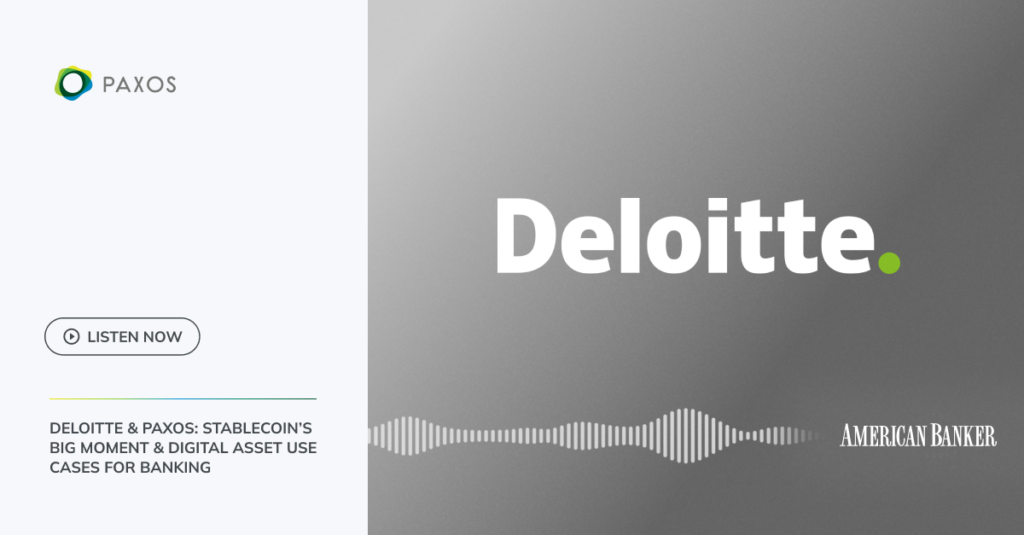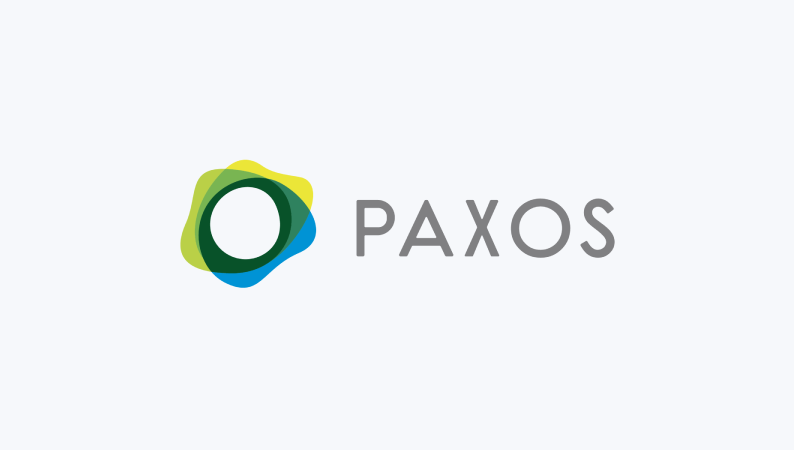
“When PayPal moves into the space and launches a stablecoin, they’re saying to other payments companies that a stablecoin is a real product.”
Navigating a New Financial Infrastructure, the latest episode of the American Banker’s podcast series, features Richard Rosenthal, Principal, Deloitte & Touche LLP and Walter Hessert, Head of Strategy, Paxos, discussing the benefits of digital assets and the future of finance. The podcast, with host Lisa Joyce, is a popular forum for innovative ideas in banking and financial services.
Tune in to listen to the entire episode and hear Richard and Walter explore these topics, and more:
- Stablecoins use cases on the horizon
- Benefits: transparency, efficiency, cost savings and access
- Positive impacts of industry regulation
Highlights from the podcast:
Richard’s perspective on the specific banking use cases and benefits of tokenizing assets:
“The benefits get at unlocking market liquidity. For example, can you free up capital that’s locked in existing settlement cycles that sometimes take a fair amount of time, particularly if they’re cross-border? Can you enhance post-trade processes? Is there a benefit of automation? We know that when you tokenize assets, you can use smart contracts to get the benefit of automated logic that can make processes more efficient. [And] we all benefit from transparency. Clients, banks and the market are looking at a range of use cases, from securities lending to tokenized money market funds, bank deposits, mortgage servicing rights to digitized repos.”
Walter’s perspective on additional end user benefits:
“I would add one thing to those benefits, which is access. By creating a lot of these other benefits through tokenization and the use of blockchain—what we are essentially doing is creating a financial system that can innovate a lot more quickly, but it also helps to drive costs down. And in driving the costs down, we can create more access to millions of people that are today left out of the existing financial system. By bringing those costs down, it creates more access, which is a really important property when we think of the value and the potential of blockchain.”
Richard’s outlook on cross-border payments:
“One thing clients talked a lot about was Deloitte’s plan to look at cross-border payments and digital cash. In cross-border payments today, there are many orchestration and synchronization problems across the lifecycle. There’s restricted service windows. There’s inconsistent data relayed across participants which creates reconciliation issues. So when we start to use distributed technology and blockchain, you can potentially get to a 24/7 basis by removing settlement windows and delays in settlement finality and hopefully getting to a place of near-instant movement of money that allows you to unlock some of this liquidity we’re talking about. That’s just one use case. But I do think banks and many others are looking at this as a promise for more efficiency and frankly, the ability to offer clients these benefits.”
“It’s a big, big, big moment in the timeline of [stablecoin] adoption.”
Walter on stablecoins inevitable rise:
“When PayPal moves into the space and launches a stablecoin, they’re saying to other payments companies, and to their tens of millions of merchants around the world, and to their hundreds of millions of consumers that have their application, that stablecoin is a real product. It’s now a trusted product that you can hold. It’s a safer product that’s backed by PayPal, that’s fully regulated by the NYDFS, issued by Paxos, and that’s going to usher in a whole new phase of adoption, a new phase of utility and a new phase of trust in stablecoins that is going to create a lot of growth over the coming years. [This] is going to be the catalyst for a lot of other major companies – from financial services to technology – to move into this space and really embrace what’s frankly one of the killer use cases of blockchain so far, US dollar stablecoins.”
Richard added:
“I do think it’s a big, big, big moment in the timeline of adoption and what’s been going on in the market. When you have a watershed moment like that, a lot of the large players start to say, “What’s my strategy?” What’s been clear to me, at least as far as the banks and a lot of the large institutional players are concerned, is they haven’t stopped figuring out what their strategy should be or how they should engage with digital assets. You see that in the headlines even beyond the PayPal announcement. A lot of banks have been studying and exploring how to engage. What should I do? Do I become a reserve bank? Do I bank a lot of the cash that’s underpinning the stablecoin? Do I provide the infrastructure to help settle, issue and support the circulation of stablecoins?…They see the opportunity. So they’re going to engage”
On the importance of regulation as an industry stabilizer
Walter on Paxos’ approach to regulation:
“At Paxos, we’ve pursued the highest level of regulatory oversight available in the market, including becoming the first digital asset firm in the country to get a New York trust status in 2015. That’s the gold standard of asset custody and financial market infrastructure, both in the US and globally. We got a “no action” letter from the SEC for tokenizing US equities and we were the first US company to receive a major payments institution license from the Monetary Authority of Singapore, the financial regulator in Singapore. [And] we continue to seek the highest levels of regulatory oversight so that we can provide infrastructure to these banks and other partners that want to offer these types of solutions and products to their customers.”
Richard elaborating on that point:
“Take a step back and approach this from the bank’s perspective of a new product launch—where there’s a new product approval process, and how you need to look at all the risks that you need to deal with. Paxos has done that with the New York State trust, the license that they’ve obtained and the work they’ve done with the New York Department of Financial Services. [It] is an example of a regulated player that is trying to meet expectations and put the necessary controls in place. And this is the same point I was making with banks in general…That’s why having state regulators, like the New York Department of Financial Services, is really important because there is work for the industry to do to carve out how this is going to work. And that’s why we spend a lot of the time trying to articulate [to banking clients] how this can be managed within the financial system.”
Want to hear the entire podcast episode for more on the future of finance?

